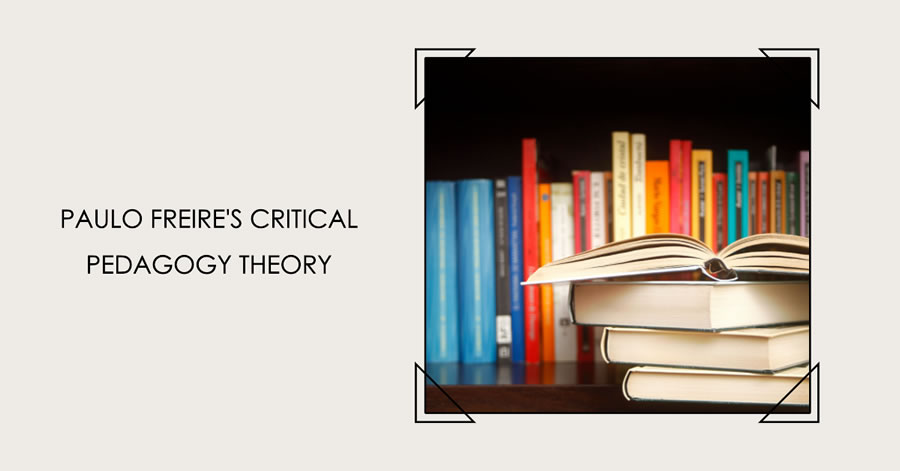Table of Contents
Introduction
Paulo Freire’s Critical Pedagogy is a revolutionary approach to education that emphasizes dialogue, critical thinking, and social transformation.
This article will provide a comprehensive overview of Freire’s work. We will highlight its key concepts and explore its implications in education. We will also look at its limitations.
Who was Paulo Freire?

Paulo Freire was a Brazilian educator and philosopher. He was an influential figure in theorizing about critical pedagogy. He contributed a philosophy of education that combines classical approaches advocated by Plato and modern Marxist, post-Marxist, and anti-colonialist authors. His influential work, Pedagogy of the Oppressed, lays out the fundamental principles of critical pedagogy.
Some of the concepts he developed in his work include the concepts of oppression, the banking model of education, the culture of silence, praxis (action & reflection), and conscientization.
Key Concepts of Paulo Freire’s Critical Pedagogy
- Oppressors VS. oppressed distinction: Education should allow those who are oppressed to get their sense of humanity and to overcome oppression.
- Banking model of education: Considering students as banks waiting to be filled with teachers’ deposits. A more human model is to think of students as active participants in the learning process.
- Culture of silence: The oppressor’s system tries to instill the model that fits the goals of the oppressors and encourages a culture of silence.
- Praxis: A cycle of action and reflection. Encouraging learners to actively engage with the world and reflecting on their experiences.
- Conscientization: The process of becoming aware of one’s own oppression and working towards social change.
What is Paulo Freire’s critical pedagogy?
Critical pedagogy is a teaching approach that aims to empower students to become active and engaged learners who can challenge social inequality and injustice.
According to Freire, traditional education reinforces oppressive social structures and maintains the status quo. Critical pedagogy seeks to change that by encouraging students to think critically. It also urges students to question the underlying assumptions and values of their education
Oppressors vs. oppressed distinction
Oppressors–oppressed distinction refers to the distinction Freire makes in his Pedagogy of the Oppressed between two models of education. Freire contends that education may follow one of two possible models:
- Education may function as a way to integrate generations into the logic of the present system and may work to lead these generations to conform to this logic.
- Education may function as a liberating and transformative tool that leads generations to think critically about reality and contribute to the transformation of their world.
These models represent the positions of the oppressor and the oppressed in an unjust society. He argues that education should aim at providing the oppressed with the tools to improve their condition and, consequently, regain their humanity. This can only occur if:
- The oppressed individual plays a role in their own liberation.
- The oppressors understand that they have to rethink their way of life and examine their own role in the oppression.
Freire affirms that:
No pedagogy which is truly liberating can remain distant from the oppressed by treating them as unfortunates and by presenting for their emulation models from among the oppressors. The oppressed must be their own example in the struggle for their redemption.
Freire, (1970, p. 54)
He also states that :
education makes sense because women and men learn that through learning they can make and remake themselves, because women and men are able to take responsibility for themselves as beings capable of knowing — of knowing that they know and knowing that they don’t.
Freire, (2004, p. 15)
The banking concept of education
Paulo Freire criticizes what he calls the banking concept of education which treats students as empty (bank) accounts waiting to be filled by the teacher.
Friere argues that the learner is not a tabula rasa, a mind not yet affected by experiences and impressions, as it is stated in the philosophy of John Locke, but rather learners must be considered active learners.
To set the goal of education as a mere transmission of knowledge from the teacher to the student fails to see one fundamental dimension of education which is the learners’ ability to participate in their own learning and in the transformation of society. This participation is referred to by Freire as committed involvement and not only a pseudo-participation.
Culture of silence
According to Paulo Freire’s Critical Pedagogy, the dominant system (the oppressor’s system) tries to instill the model that fits the goals of the oppressors and encourages a culture of silence. The aim of education must be to achieve a form of liberation where the oppressed are prompted to develop the critical awareness necessary to break the pattern of oppression, the culture of silence.
Praxis (action & reflection)
Central to Freire’s work is the idea of praxis, which involves a cycle of action and reflection. Praxis is a key component of Critical Pedagogy, as it encourages learners to actively engage with the world and reflect on their experiences.
Conscientization
Another important concept in Freire’s work is conscientization, which involves the process of becoming aware of one’s own oppression and working toward social change. Conscientization is an ongoing process that requires critical reflection and action.
Implications of Freire’s ideas
Incorporating Paulo Freire’s Critical Pedagogy into your teaching can have significant positive impacts on your students’ development.
Here are key areas to consider:
- The teacher is a facilitator: In a critical pedagogy classroom, the teacher acts as a facilitator rather than an authority figure. The teacher encourages students to participate actively in their learning and to engage in dialogue and discussion.
- Teachers and students are both learners: Freire believed that learning should be a collaborative, social process. Teachers and students should work together to co-create knowledge, rather than the teacher solely imparting information. This helps establish a more equitable power dynamic in the classroom.
- Connection to the real world: The teacher helps them to make connections between their learning and the real world. Students are encouraged to share their experiences and perspectives and to think critically.
- Developing critical literacy: The teacher has to encourage learners to approach the media they consume with a critical eye. By thinking deeply about what they read, watch, and hear, students can begin to identify and challenge inequality and injustice. This process of critical reflection allows students to ask important questions about the world around them.
- Encouraging active inquiry: Freire argued that by stifling curiosity in the classroom, we limit students’ ability to become mature, independent thinkers who can make a positive difference in the world. By fostering a culture of inquiry, students can explore and reflect on the world in ways that empower them to take action and effect positive change.
- Different assessments: Assessment in a critical pedagogy classroom is also different from traditional assessment methods. Instead of relying solely on standardized tests, critical pedagogy assessment focuses on the student’s ability to apply their learning to real-world situations and to demonstrate their critical thinking skills.
Limitations of Paulo Freire’s Pedagogy
While Paulo Freire’s Critical Pedagogy has been widely praised, it is not without its critics.
- Content knowledge: Some argue that it places too much emphasis on dialogue and critical thinking, and not enough on content knowledge.
- An idealistic approach to education: Others argue that it is overly idealistic and does not take into account the realities of power dynamics in the classroom.
- Lack of empirical evidence: Some critics argue that critical theory relies too heavily on abstract concepts and lacks empirical evidence to support its claims. They argue that the approach is overly focused on theory and fails to provide concrete solutions to real-world problems.
- Political bias: Some critics argue that critical theory is inherently biased toward leftist politics. It fails, therefore, to provide a balanced perspective. They argue that the approach is overly focused on issues of race, gender, and class. By contrast, it neglects other important social factors.
- Narrow focus: Some critics argue that critical theory has a narrow focus on power structures and systems of oppression. It neglects other important social factors, such as culture, history, and psychology.
- Lack of clarity: Some critics argue that critical theory is often unclear and difficult to understand, which makes it inaccessible to many people. They argue that the language and concepts used in critical theory can be unnecessarily convoluted and abstract.
- Overemphasis on victimhood: Some critics argue that critical theory places too much emphasis on victimhood. It, therefore, fails to acknowledge the agency of individuals in shaping their own lives. They argue that the approach can be disempowering and discourages people from taking responsibility for their own actions.
Advantages of Paulo Freire’s Pedagogy
Despite these critiques, Freire’s advocates still adhere to his pedagogy:
- They say that it remains an important contribution to the field of education.
- They think that its emphasis on dialogue, critical thinking, and social transformation has inspired countless educators and learners around the world to work toward a more just and equitable society.
Conclusion
Paulo Freire’s critical pedagogy theory is considered by its advocates a transformative approach to education that challenges traditional models of teaching and learning. It emphasizes the importance of critical thinking, empowerment, and social justice in education. Although it has faced criticisms and challenges, critical pedagogy continues to inspire educators and learners worldwide to create a more just and equitable society.
References
Freire, P. (1970). Pedagogy of the Oppressed. New York, Continuum.
Freire, P. (2004). Pedagogy of Indignation. Boulder: Colorado, Paradigm.


